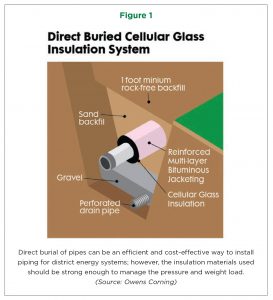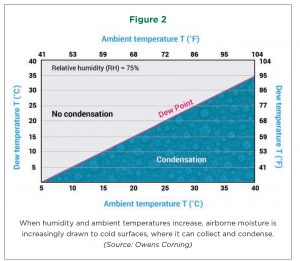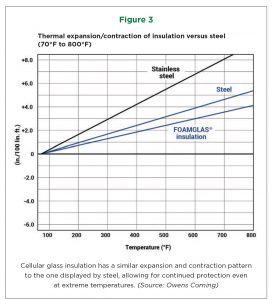Six Effective Practices for Insulating District Energy Systems
While the materials that insulate critical district energy systems may be out of sight, they should never be out of mind. Whether located in direct-buried or tunnel environments, district energy systems require special consideration when it comes to specifying insulation for steam, hot water, and chilled water pipes.
Longevity and Cost Considerations
If you are not familiar with district energy, the term refers to systems that heat and cool many buildings in a network, or district, from a central plant location. These systems circulate steam as well as hot water and chilled water via a network of underground pipes. According to the International District Energy Association, district energy systems are often used by universities, cities, communities, airports, military bases, industry, and health-care facilities. District energy systems and the related infrastructure often are intended for long-term use, and some of the systems in place today date back to the latter part of the 19th century and early decades of the 20th century. The long lifespan of such systems puts increased pressure on getting the design right at the outset, proper installation, and regular system maintenance. Underground locations make excavation and retrofits costly. In both university and municipal systems, the cost of exposing, repairing, or replacing buried piping for district energy systems could be as much as $50,000 per foot because pipes may be placed 10.7 to 12.2 meters (35 to 40 feet) below the surface. From an economic perspective, the cost of removing and replacing failed insulation can be three to five times more than the initial installation cost.
Unique Design Considerations
Pipes located in direct-buried and vaulted (tunnel) applications are subject to threats posed by moisture and compressive load. These threats can compromise thermal performance, reduce efficiency, cause corrosion, and hinder a system’s overall longevity. Advance consideration of the challenges a district energy insulation system is likely to face—including extreme operating conditions—can avoid costly remediation later and help ensure system longevity and efficient functioning over time.
How early should these considerations begin? During the design phase is ideal, given the underground locations of district energy systems, as excavation can be expensive, disruptive, and dangerous.
The design phase is the time to ask, “what can go wrong?” Too often, specifications do not account for the extremes that can arise during practical operations. Some worst-case questions to ask include:
- What are the risks posed when (not if) a tunnel floods?
- How may infrastructure enhancements contribute to increased traffic and increased compressive load?
- Is the system equipped to manage abrupt disruptions in operations, as was seen in 2020 when many university campuses shut down?
Responses to these questions can impact not only the design of the district energy system, but also the insulating materials specified.
The following are some practical parameters to assess early in the process.
- Load-bearing requirements of the piping and insulation system [direct buried]
- Water tables, hydrostatic loading potential, vapor drive, and potential for flooding [vaulted and direct buried]
- Ambient temperature and humidity impact on other equipment or assets sharing the space or adjacent to the systems [vaulted]
- Potential for system movement because of changes in temperature [vaulted and direct buried]
- Heat transfer fundamentals [vaulted and direct buried]
District Energy Systems and Energy Efficiency
The potential to achieve an improved environmental footprint is one element driving the use of district energy systems. Inherent efficiencies can arise from a system utilizing a centralized plant to generate steam, hot water, and chilled water, all of which can be transported to other buildings for use in climate control, hot-water heating, and humidification processes. Compared to many other systems, district energy systems can provide sustainable climate control for several buildings at a time. Additionally, from a sustainability perspective, these systems can help to reduce the emissions from energy generation because less energy may be needed to provide the required temperature control than if the same amount were provided in another manner.
For multi-building facilities like university campuses or airports, which often run their own power generation and use district energy systems, the thermal efficiency of the system can help the site reduce greenhouse gas emissions and improve its carbon footprint. The more efficient the overall system, in terms of providing and returning heating and cooling, the more energy waste is reduced.
With consideration of the potential challenges a district energy system may face, a comprehensive design method should account for factors including the location of pipes, moisture threats and pipe movement, and material that can deliver efficient temperature control over the long term. Pipes are a primary source of system heat loss and gain. Variations in pipe temperature can strain the heating or cooling production equipment, thus compromising system efficiency. The risk of such inefficiency highlights the importance of correctly designing and installing insulation and accessories capable of mitigating both anticipated and extreme operating conditions.
Below-Grade Insulation: Weight and Dimensional Stability
When specifying insulation to be used underground, it can be important to address the type of pipe being insulated: steam, chilled water, hot water, etc. Other factors to consider on the proverbial laundry list include the operating temperature, consistency of that temperature, pipe dimensions, insulation thickness, burial depth, number and nature of runouts, soil type, bearing strength and electrical potential, water table, material expansion and contraction, access, and traffic load. We will touch more on water and expansion later.
Direct burial can be a practical way to install underground steam pipes, as the practice reduces the costs associated with tunnel construction and maintenance and may allow faster installation. However, buried pipes can experience multiple strains, including hydrostatic pressure and high weight loads from the pressure of soil, traffic, and other weight at ground level.
Six Effective Practices for the Design Stage
With the challenges of district energy systems in mind—and the potential costs of not getting the system right—here are six best practices to keep in mind when specifying insulation in district energy systems.
#1: Guard against Compression Creep [Direct Buried]
Compressive strength of a material is particularly important for direct burial environments and helps provide process control for an extended period. Beyond the heavy weight of the soil, mechanical systems, construction, and traffic all present a weight burden. When insulation compresses, deforms, or deflects, there can be a noticeable reduction in the performance of the insulation system. (See Figure 1.) Cellular glass insulation is one of the materials that delivers a high level of compressive strength that does not require additional structural protections. NIA offers the Insulation Materials Specification Chart (available for free at www.insulation.org/about-insulation/system-design/techs-specs) that lists the properties of common insulation materials.
Insulation installed on buried pipes should have a wide service temperature range and high compressive strength, and it should be resistant to deformation. Choose materials that can maintain their structural stability and thermal properties even
when in direct burial applications.
#2: Defend against Moisture and Corrosion Risk [Vaulted and Direct Buried]
The underground location of district energy systems means that moisture infiltration is a persistent factor to manage. It is estimated that the vast majority, about 98%, of problems with insulation stem from moisture.1
Areas prone to flooding and areas with high water tables present added concern. Similarly, vault-entrenched pipes can be subject to dripping water from overhead pipes and equipment, or can experience tunnel flooding. Moisture ingress into insulated pipes can reduce the effectiveness of insulation’s protection; increase thermal conductivity; and
raise the potential for other types of damage, including corrosion.
Corrosion under insulation (CUI) can occur when steel pipes come into contact with moisture, especially while operating at 25°F to 350°F (-4°C to 175°C). CUI can damage system integrity and may lead to unexpected repairs, system downtime, or even total failure. Impermeable insulation defends against moisture infiltration, supporting system longevity and cost-effective functioning for both buried and vaulted pipes.
As noted earlier, insulation should be designed to manage extreme conditions, not best-case conditions, so engineers’ calculations should consider times when the system will need to function outside of normal design parameters. Chilled-water systems, for example, are at risk from severe humidity or use during extreme conditions. Failure to plan for extreme conditions may result in insulation that is not thick enough to maintain insulation system surface temperatures high enough for condensation control.
Submersion during flooding is a concern for both buried and entrenched pipes. Utilizing a closed-cell, impermeable insulation material can help protect steam or chilled-water pipes by blocking water from entering the insulation and reaching pipe surfaces.
Chilled-water pipes may face additional risk from moisture as they operate at temperatures below ambient. Typical service temperatures range between 25°F and 59°F (-4°C and 15°C), making them prone to challenges from vapor drive. This occurs when ambient temperatures are higher than the temperature within the pipe. (See Figure 2.)
As moisture at an ambient temperature is drawn toward colder pipes, it can cause condensation on the outside of the insulated system. Moisture forming on the outside of insulated pipes can create several problems, including mold and mildew growth, potentially generating health risks to pedestrians and workers in tunnels. In vaulted applications, permeable insulation materials installed without a vapor barrier can allow moisture to infiltrate into the insulated system. This situation introduces the potential for pipe corrosion to occur, reducing the insulation’s thermal efficiency, and adding stress to the process system. While vapor barriers can help mitigate this situation, district energy applications are typically designed to last for decades, and over time wear and tear as well as mechanical damage can compromise the integrity of a vapor barrier. Any tear, puncture, or opening can allow moisture to infiltrate and introduce the aforementioned consequences.
#3: Consider Risk to Other Assets [Vaulted]
As water, vapor, or compressive stress causes insulation deterioration, radiant heat can cause damage to nearby utilities, such as fiber-optic cables. In urban environments—for example, in cities—multiple components are often tightly placed in a small space, so it is important to install materials that will protect components operating in the system to support efficiency.
Tunnels used for chilled water and steam pipes also can house other utilities including power and computer networks. Any damage to heating or cooling pipes could impact additional systems as climate conditions within the tunnels change.
#4: Plan for Thermal Expansion [Vaulted and Direct Buried]
During design, attention should be paid to the anticipated expansion of pipes. Piping may change size based on temperature, and addressing expansion potential helps avoid problems once pipes are in use. Pipe growth is often managed using expansion loops or mechanical expansion/contraction devices, which also need to be insulated. Successfully designed insulation for these loops or devices supports system longevity. Using insulating materials with a coefficient of thermal expansion similar to the pipes’ may reduce the potential for gaps and help maintain the long-term thermal efficiency of the insulation system. (See Figure 3).
#5: Strive for Thermal Stability [Vaulted and Direct Buried]
Insulation installed in district energy systems needs to help maintain thermal consistency between the start and end of the line. It also should help maintain an outer surface temperature acceptable for protection of personnel and surrounding equipment or vegetation in direct burial applications.
Calculations determining acceptable heat transfer should include consideration of the type and the moisture content of the soil. These soil conditions will affect the overall heat transfer and piping system surface temperatures.
While most buried pipes carry above-ambient material, such as hot water and steam, piping in tunnels and vaults also can be used for chilled-water systems—an arrangement most likely in district cooling systems. Adequate insulation protects pipes from heat gain that could reduce cooling system efficiency, stress the chiller, and hike overall energy costs.
#6: Don’t Overlook the Jacketing
The selection of a proper jacketing material should be incorporated into the district energy design considerations. Depending on the application, jacketing helps protect mechanical resources, mitigate against moisture infiltration, and contribute to the aesthetics of the space. Jacketing selection in direct buried applications should consider mechanical protection against backfill and take into account the water table. In vaulted or tunnel applications, jacketing can help protect equipment from the wear and tear resulting from maintenance activities or occupant traffic, defend against moisture resulting from vapor drive, and support a clean and pristine environment in areas such as vaulted entries to stadiums or workplaces.
Conclusion
When selecting insulation to be used on hot and chilled pipes in a district energy system, several factors can influence design. However, using a process-driven design matrix and specifying materials with the necessary qualities on the checklist can help form an insulation specification capable of delivering long-term protection. The insulation choice should provide high compressive strength, help prevent moisture penetration, promote thermal efficiency by limiting heat transfer, and demonstrate an expansion rate similar to the piping material. Applying best practices during the design stage can help ensure the cost-effective and long-term function of a district energy system.
Three Questions and Answers
with an Infrastructure Manager
Scott Templeton is Senior Manager of Customer and Infrastructure at Corix Cleveland Thermal, a provider of district energy solutions and infrastructure services for communities across Canada and the United States. With 29 years of experience overseeing district energy systems, Templeton offers a manager’s perspective to questions surrounding district energy systems.
What qualities are imperative when it comes to specifying insulation for district energy systems?
A good R-value is essential for the steam lines, and you also want good protection for the pipes. …A rigid material, so it doesn’t get compressed when buried, and [one] impermeable to water… protects the piping and the integrity of the insulation system.
In a direct-buried environment, how do you assess the thermal performance of insulation installed on pipes?
We do regular aerial scans where cameras assess the thermal performance. We recently did a flyover and thermal scan and the piping was completely invisible. No heat sync is a good indication and tells you that your insulation is doing a good job. The only thermal indication we saw was the manhole cover, which will naturally be a little warmer.
How will district energy systems play a role in the future?
There is a big government push in the U.S. for greenhouse gas reduction and efforts to lower the carbon footprint. The regulated nature of district energy systems means these systems can play a big role in reducing energy use. A consolidated, single-source approach means less emissions and more efficiency. This is being lived out in projects across Canada and here in the United States. For example, in early 2018, Corix Cleveland Thermal completed a $28MM project to re-power the steam business by installing all new compressed natural gas (CNG) boilers. I believe district energy in the U.S. is going to be the future when it comes to controlling greenhouse gas and reducing the carbon footprint in most major cities. Canada is a step ahead of the U.S. and is requiring district energy systems to be included with new development and enforcing a carbon tax to buildings that do not connect to the system.
References
1. Adams, Ludwig. “Thermal Conductivity of Wet Insulations.” ASHRAE Journal. pp. 61–62. Oct. 1974




